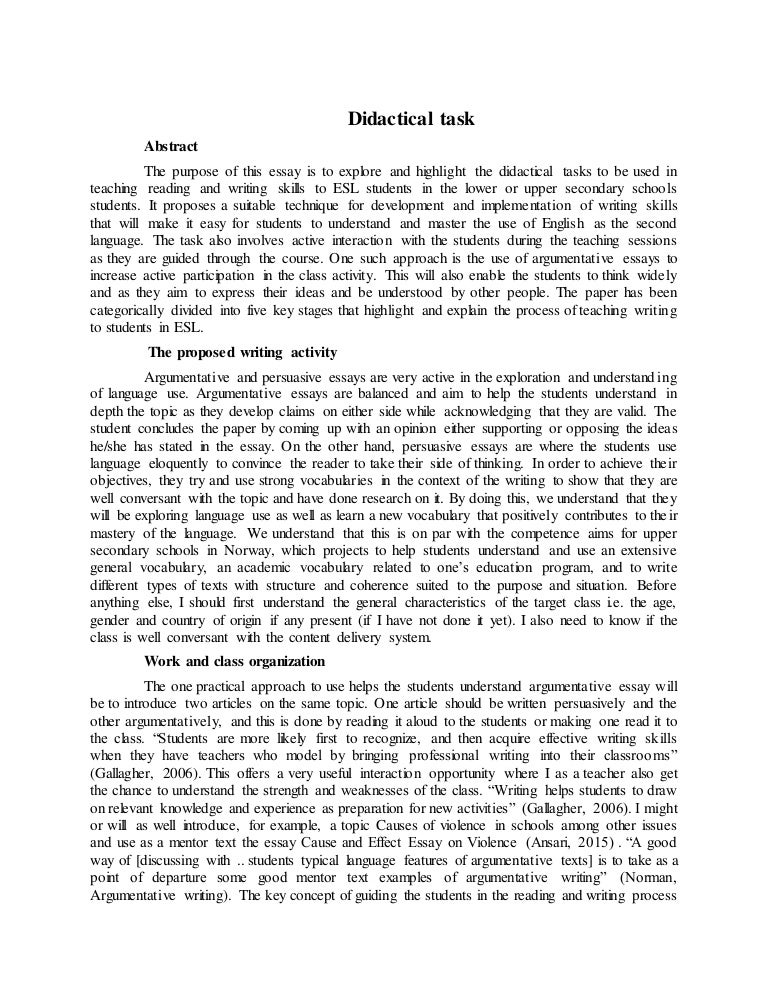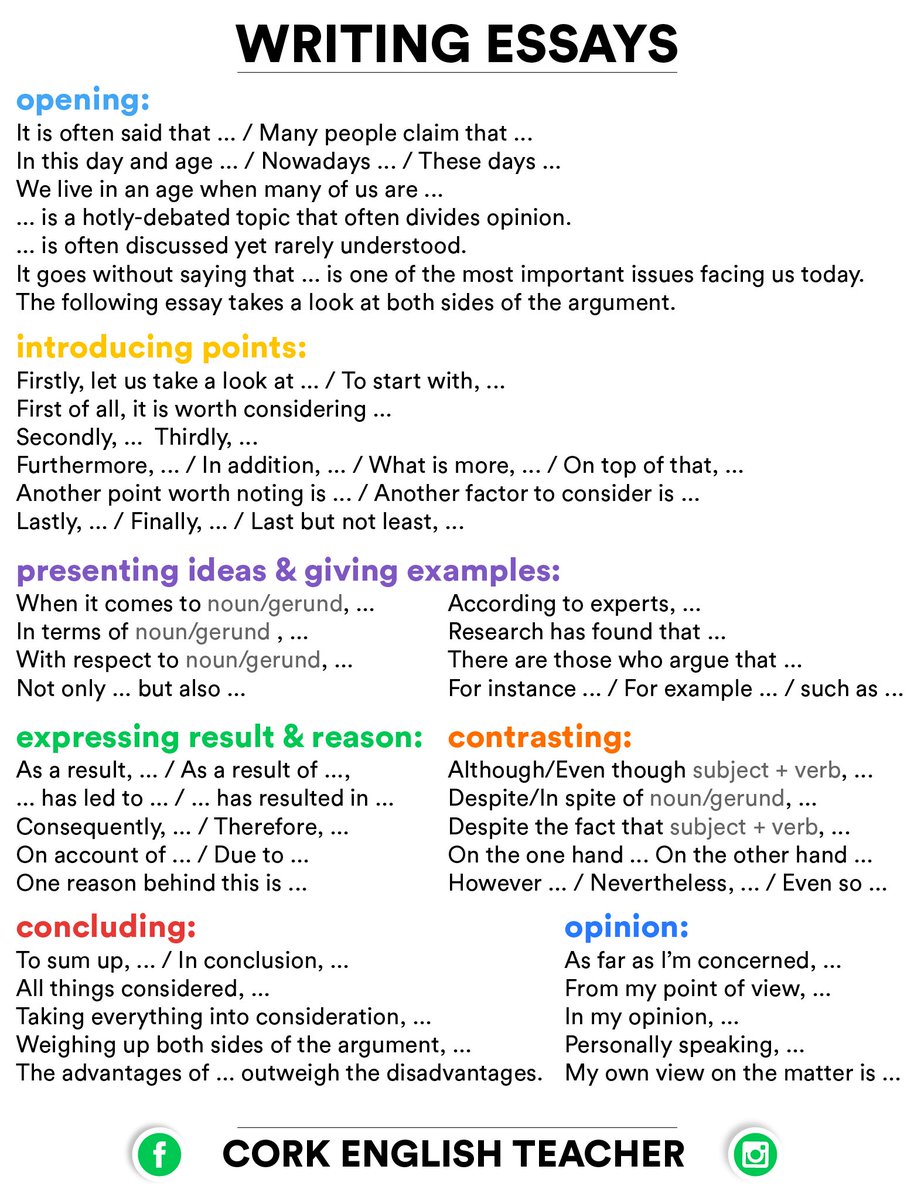
Essay Writing A complete guide students teachers learn to plan and structure a range of essay types, the essay format. essay topics, essay paragraphs, prompts and essay writing skills for expository, narratives, persuasive essays and many more. Essay writing tips made simple Do my Teaching Essay Writing research paper for me!—our experts are always ready to help Teaching Essay Writing you Boost their performance, Have more time to enjoy life at college, etc. Our online writing company has a perfect reputation among students—many of them have become our regular customers who recommend our services to their An essay can not be just a piece of writing about general things everybody knows and understands perfectly. So, teach your students that they should not be in a hurry to write their essays at once they've chosen the topic. Make them decide upon the purpose of an essay. When a student perfectly understands what he writes an essay for, it will be
3 Ways to Teach Essay Writing - wikiHow
Essay writing is an essential skill for every student. Whether writing a particular type of academic essay such as persuasive, narrative, descriptive, or expository or a timed exam essay, the key to getting good at writing is to write, teaching essay writing. Creating opportunities for our students to engage in extended writing activities will go a long way to helping them improve their skills as scribes, teaching essay writing. But, putting the hours in alone will not be enough to attain the highest levels in essay writing.
Practice must be meaningful. Once students have a broad overview of how to structure the various types of essay, they are ready to narrow in on the smaller details that will enable them to fine-tune their work as a lean vehicle of their thoughts and ideas. In this article, we will drill down to some of the aspects that will teaching essay writing students in taking their essay writing skills up a notch.
Many of the ideas and activities can be integrated into broader lesson plans based on essay writing. Often, though, they will work effectively in isolation — just as athletes isolate physical movements to drill that are relevant to their sport. When these movements become second nature, they can be repeated naturally in the context of the game, or in our case, the writing of the essay.
Given the purpose of an essay is generally to present a logical and reasoned argument, investing time in organising arguments, ideas, teaching essay writing, and structure would seem to be time well spent. Given that essays can take a wide range of forms and that we all have our own individual approaches to writing, it stands to reason that there will be no single best approach to the planning stage of essay writing. That said, there are a number of helpful hints and techniques we can share with our students to help them wrestle their ideas into a writable form, teaching essay writing.
Whether students are tackling an assignment that you have set them in class, or responding to an essay prompt in an exam situation, they should get into the habit of analyzing the nature of the task itself. To do this they should unravel the meaning of the question or prompt. Students can practice this in class by responding to various essay titles, questions, and prompts thereby gaining valuable experience in breaking these down.
Have students work in groups to underline and dissect the keywords and phrases and to discuss together what exactly is being asked of them in the task. Teaching essay writing they being asked to discuss, describe, persuade, or explain? Understanding the exact nature of the task at hand is crucial before going any further in the planning process, never mind the writing process.
Once students have understood what the essay task is asking of them they should consider what they know about the topic and, often, how they feel about it. Brainstorming and mind-mapping what they know about a topic offers them an opportunity to uncover not just what they already know about a topic, but also gives them a chance to reveal to themselves what they think about the topic. This will help guide them in structuring their research and, later, the essay they will write itself.
The previous step above should reveal to students the general direction their research will take. With the ubiquitousness of the internet, gone are the days of students relying on a single well-thumbed encyclopaedia from the school library as their sole authoritative source in their essay. If anything, the real problem for our students today is narrowing down their sources to a manageable number, teaching essay writing.
Students should use the information from the previous step to help here. At this stage, it is important that they:. Once these stages have been completed the student is ready to organise their points into a logical order.
There are a number of ways for students to organize their points in preparation for writing. They can use graphic organizers, post-it notes, or any number of available writing apps. The important thing for them to consider here is that their points should follow a logical progression.
This progression of their argument will be teaching essay writing in the form of body paragraphs that will inform the structure of their finished essay, teaching essay writing. The number of paragraphs contained in an essay will depend on a number of factors such as word limits, time limits, the complexity of the question etc. Generally speaking, essay paragraphs will focus on one main idea that is usually expressed in a topic sentence that is teaching essay writing by a series of supporting sentences that bolster that main idea.
Though students will most likely be familiar with the broad generic structure of essays, it is worth investing time to ensure they have a clear conception of how each part of the essay works, that is, of the exact nature of the task it performs. Introduction: Provides the reader with context for the essay. Except in exam situations and the like, thorough editing is an essential aspect in the writing process. Often, teaching essay writing, students struggle with this aspect of the process the most.
After spending hours of effort on planning, research, and writing the first draft, teaching essay writing, students can be reluctant to go back over the same terrain they have so recently travelled. It is important at teaching essay writing point to give them some helpful guidelines to help them to know what to look out for. The following tips will provide just such help:. One Piece at a Time: There is a lot to look out for in the editing process and often students overlook aspects as they try to juggle too many balls during the process.
One effective strategy to combat this is for students to perform a number of rounds of editing with each focusing on a different aspect. For example, teaching essay writing first round could focus on content, teaching essay writing, the second round on looking out for word repetition use a thesaurus to help herewith the third attending to spelling and grammar. Sum It Up: When reviewing the paragraphs they have written, a good starting point is for students to read each paragraph and attempt to sum up its main point in a single line.
If this is not possible, their readers will most likely have difficulty following their train of thought too and the paragraph needs to be overhauled. This may require some skilful time management on the part of the student, for example, a student rush-writing the night before the deadline does not lend itself to effective editing.
Read It Aloud: This time-tested editing method is a great way for students to identify mistakes and typos in teaching essay writing work. We tend to read things more slowly when reading aloud giving us the time to spot errors. Also, when we read silently our minds can often fill in the gaps or gloss over the mistakes that will become apparent when we read out loud. Phone a Friend: Peer editing is another great way to identify errors that our brains may miss when reading our own work.
Use Tech Tools: We need to ensure our students have the mental tools to edit their own work and for this they will need a good grasp of English grammar and punctuation, teaching essay writing. However, there are also a wealth of tech tools such as spellcheck and grammar checks that can offer a great once-over option to catch anything students may have missed in earlier editing rounds.
Putting the Jewels on Display: While some struggle to edit, others struggle to let go. There comes a point teaching essay writing it is time for students to release their work to the reader. They must learn to relinquish control after the creation is complete. This will be much easier to achieve if the student feels that they have done everything in their control to ensure their essay is representative of the teaching essay writing of their abilities and if they have followed the advice here, teaching essay writing, they should be confident they have done so.
Content for this page has been written by Shane Mac Donnchaidh. A former principal of an international school and university English lecturer with 15 years of teaching and administration experience. Editing and support for this article have been provided by the literacyideas team. Skip to content, teaching essay writing. DOWNLOAD FREE. Writing Expand child menu Expand. The Foundations of Writing Expand child menu Expand.
Writing to Entertain Expand child menu Expand. The Narrative Expand child menu Expand. Poetry Expand child menu Expand. Writing to Inform Expand child menu Expand. Writing to Persuade Expand child menu Expand.
Reading Expand child menu Expand. The Foundations of Reading Teaching essay writing child menu Expand. Reading Literature Expand child menu Expand. Reading Informational Texts Expand child menu Expand. Language Expand child menu Expand, teaching essay writing. Language Conventions Expand child menu Expand. Toggle Menu Close. Search for: Search.
Cambridge C1 Advanced (CAE): How to Write an Essay
, time: 14:22How to Teach Essay Writing Skills – What Binder Education

Essay Writing A complete guide students teachers learn to plan and structure a range of essay types, the essay format. essay topics, essay paragraphs, prompts and essay writing skills for expository, narratives, persuasive essays and many more. Essay writing tips made simple Strategies In Teaching Essay Writing writers Strategies In Teaching Essay Writing have a keen eye on important details in your essays such as spelling, grammar, etc. you will be assured of an error-free project. Commitment to help Strategies In Teaching Essay Writing clients. When an essay writer is committed to helping their clients, they are Oct 28, · Beyond the Essay: Teaching Public Writing Wednesday, November 3, – pm, Zoom Hosted by Anna Zeemont. This workshop–open to students in any discipline–will explore writing pedagogies that look beyond the professor as the sole reader and narrow understandings of “academic” writing to incorporate public-facing, multimedia, student-centered projects that speak to real
No comments:
Post a Comment